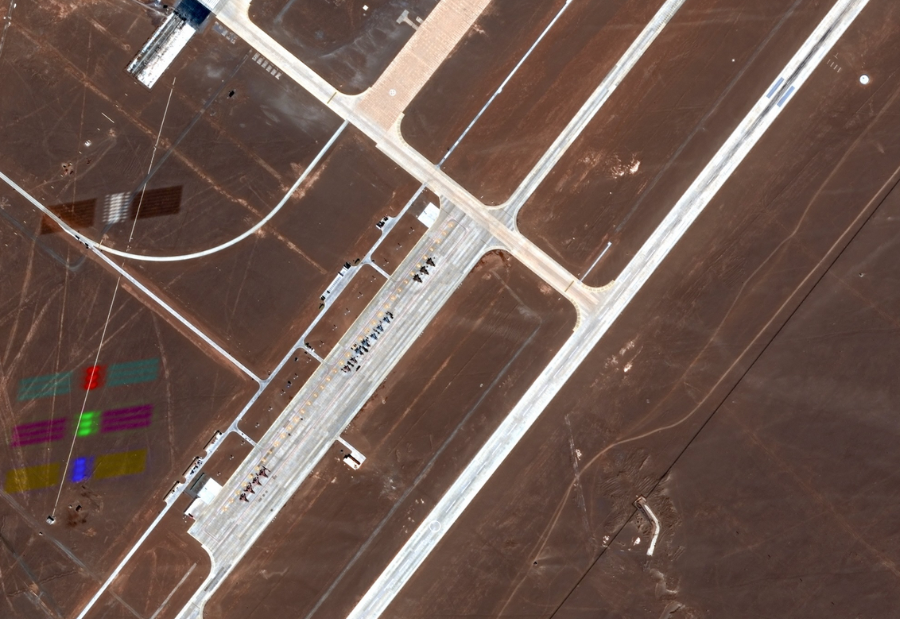An unusual orbital encounter has led to a striking image of a SpaceX Starlink satellite appearing in a high-resolution photo of a secret Chinese military airbase.
On 21 August, one of SpaceX’s broadband-beaming Starlink satellites passed directly through the view of a private American Earth-observation satellite photographing Dingxin Airbase in the Gobi Desert of western China. The rare alignment created unique visual effects in the image.
The picture, taken by a WorldView Legion satellite orbiting at 312 miles altitude, shows fighter jets parked near a runway against the desert landscape. In the upper-left corner, a faint oblong figure with a bright centre and two darker arms can be seen — the result of the Starlink satellite crossing paths at the exact moment of capture.
The satellite was identified as Starlink spacecraft number 33828. Its presence created rainbow-like reflections on the surface below, described by experts as a “pan-sharpening spectral artifact.” This happens when high-resolution black-and-white data and colour data are combined while another satellite moves past at extremely high speeds of nearly 8 kilometres per second.
“Physics turned a technical imaging challenge into accidental art,” wrote an executive who shared the image on social media. They explained that while the event highlights how busy near-Earth space has become, capturing another satellite in this way remains an extraordinary rarity.
“Capturing another satellite like this in an Earth-observation image is extremely rare,” the executive added. “In this case, a Starlink satellite happened to pass through our field of view at just the right moment while our sensors were mid-collection — an extraordinary alignment, given the vastness of space and the fact that we were travelling at an astonishing relative velocity of about 1,400 metres per second.”
Starlink, operated by Elon Musk’s SpaceX, has previously drawn criticism from astronomers. Reflections from its thousands of low-Earth orbit satellites create streaks across telescope images, disrupting large surveys such as those from the Vera Rubin Observatory in Chile. The satellites also affect radio astronomy, as their internal electronics can interfere with sensitive radio frequencies even when the internet beams are switched off.
With more than 8,300 active satellites already in orbit, experts in space sustainability have raised concerns about the growing risk of collisions and operational complexities. While Earth-observation satellites are not currently impacted, specialists warn that the continued rise in low-Earth orbit traffic could pose future challenges.
“The ‘crowded’ space domain is not just about collision avoidance anymore — it is about understanding how these overlapping capabilities create both opportunities and complexities for mission planning,” the executive noted. “That is why integrated space domain awareness is not just nice to have anymore — it is foundational to mission success.”
Dingxin Airbase, the location captured in the image, is one of China’s most secretive military facilities. It is used for advanced fighter jet drills, bomber exercises and the testing of new military drones.
Also read: Viksit Workforce for a Viksit Bharat
Do Follow: The Mainstream formerly known as CIO News LinkedIn Account | The Mainstream formerly known as CIO News Facebook | The Mainstream formerly known as CIO News Youtube | The Mainstream formerly known as CIO News Twitter |The Mainstream formerly known as CIO News Whatsapp Channel | The Mainstream formerly known as CIO News Instagram
About us:
The Mainstream formerly known as CIO News is a premier platform dedicated to delivering latest news, updates, and insights from the tech industry. With its strong foundation of intellectual property and thought leadership, the platform is well-positioned to stay ahead of the curve and lead conversations about how technology shapes our world. From its early days as CIO News to its rebranding as The Mainstream on November 28, 2024, it has been expanding its global reach, targeting key markets in the Middle East & Africa, ASEAN, the USA, and the UK. The Mainstream is a vision to put technology at the center of every conversation, inspiring professionals and organizations to embrace the future of tech.




